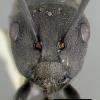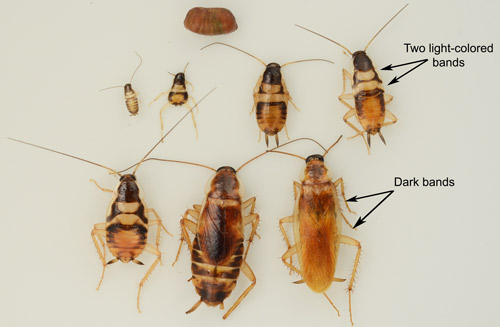
Is that little guy doing any harm to my colony or just friend with benefit?


Is that little guy doing any harm to my colony or just friend with benefit?
Polyrhachis dives. I 5 Queens, 83 Workers. << This colony keep biting and pulling 2 of their queens from the nest, so i decided to get them out. P. Dives III and P. Dives IV.
Polyrhachis dives. II 1 Queen, 16 Workers. First egg February 12th 2019.
Polyrhachis dives. III 1 Queen, First egg May 15th 2019.
Polyrhachis dives. IV 1 Unfertilized Queen.
Ignore this post, i was wrong ![]()
I am no expert by any stretch, but to me, it looks like a young brown-banded cockroach. Not that you asked ![]()

Edited by Shifty189, February 20 2019 - 7:30 PM.
Its an ant loving cricket. Totally cool and ok!
We should respect all forms of consciousness. The body is just a vessel, a mere hull.
Welcome to Lazy Tube - My Camponotus Journal
A lot of the Myrmecophilidae are commensal neither symbiotic or parasitic. However I'd keep a close eye on it.
Why do you have L. niger in Indonesia? did you acquire them from a seller over seas? I'm aware of some sellers in France and Germany that are willing to ship internationally and often stock that species.
Edited by FSTP, February 18 2019 - 11:08 AM.
I see you live in Indonesia.
Given this, I highly doubt that the ants are indeed L. niger. Can you make a post about them in the ID center, or even in this topic?
Here's a template of how to do it:
http://www.formicult...t-a-new-thread/
I see you live in Indonesia.
Given this, I highly doubt that the ants are indeed L. niger. Can you make a post about them in the ID center, or even in this topic?
I was gonna ask that XD
I'm thinking they are Laisius. that ant cricket looks could be Mymecophilis acervorem cf which is known to be commensal with Laisius spp. They're found all through Europe that's why I asked if he got the ants from the EU. It would be odd to find an ant loving cricket specialized for laisius to be found in Indonesia
I'm thinking they are Laisius. that ant cricket looks could be Mymecophilis acervorem cf which is known to be commensal with Laisius spp. They're found all through Europe that's why I asked if he got the ants from the EU. It would be odd to find an ant loving cricket specialized for laisius to be found in Indonesia
There are a 2 kinds of commonly found ant crickets here, one larger and one smaller. The smaller is accepted by black crazy ants, but attacked by yellow (still live in their nests though) The larger is accepted by yellow crazy ants.
A lot of the Myrmecophilidae are commensal neither symbiotic or parasitic. However I'd keep a close eye on it.
Why do you have L. niger in Indonesia? did you acquire them from a seller over seas? I'm aware of some sellers in France and Germany that are willing to ship internationally and often stock that species.
No, i found it under a concrete block in my garden.
Actually there are still 4 or 5 queens under it, but they moved out because i sprayed water at their nest to get the queen.
I'm pretty sure that Lasius niger is native to Indonesia.
Let me know if I'm wrong.
Edited by ANTndonesia, February 18 2019 - 5:13 PM.
Polyrhachis dives. I 5 Queens, 83 Workers. << This colony keep biting and pulling 2 of their queens from the nest, so i decided to get them out. P. Dives III and P. Dives IV.
Polyrhachis dives. II 1 Queen, 16 Workers. First egg February 12th 2019.
Polyrhachis dives. III 1 Queen, First egg May 15th 2019.
Polyrhachis dives. IV 1 Unfertilized Queen.
I can tell you from those pictures that those aren't L. niger.
There aren't even any Lasius in Indonesia.
I can tell you from those pictures that those aren't L. niger.
There aren't even any Lasius in Indonesia.
Well then, my bad, seem like I'm wrong and gonna go for ID now.
Edited by ANTndonesia, February 18 2019 - 5:34 PM.
Polyrhachis dives. I 5 Queens, 83 Workers. << This colony keep biting and pulling 2 of their queens from the nest, so i decided to get them out. P. Dives III and P. Dives IV.
Polyrhachis dives. II 1 Queen, 16 Workers. First egg February 12th 2019.
Polyrhachis dives. III 1 Queen, First egg May 15th 2019.
Polyrhachis dives. IV 1 Unfertilized Queen.
They look like black Crazy ants Paratrechina longicornis
which is probably why the cricket is there, bca colonies often have those crickets
Polyrhachis dives. I 5 Queens, 83 Workers. << This colony keep biting and pulling 2 of their queens from the nest, so i decided to get them out. P. Dives III and P. Dives IV.
Polyrhachis dives. II 1 Queen, 16 Workers. First egg February 12th 2019.
Polyrhachis dives. III 1 Queen, First egg May 15th 2019.
Polyrhachis dives. IV 1 Unfertilized Queen.
0 members, 1 guests, 0 anonymous users